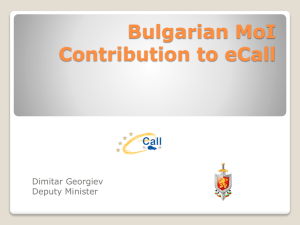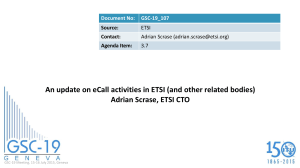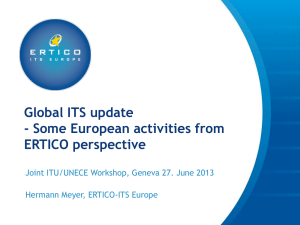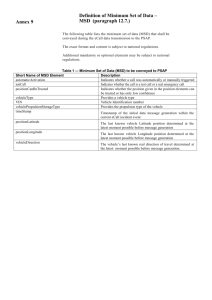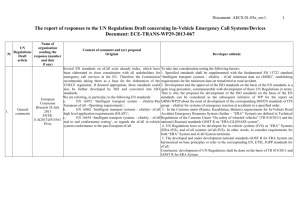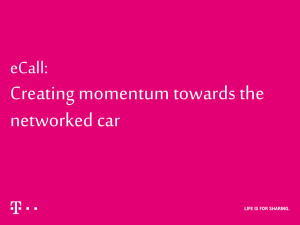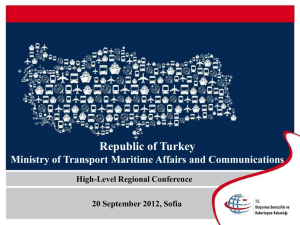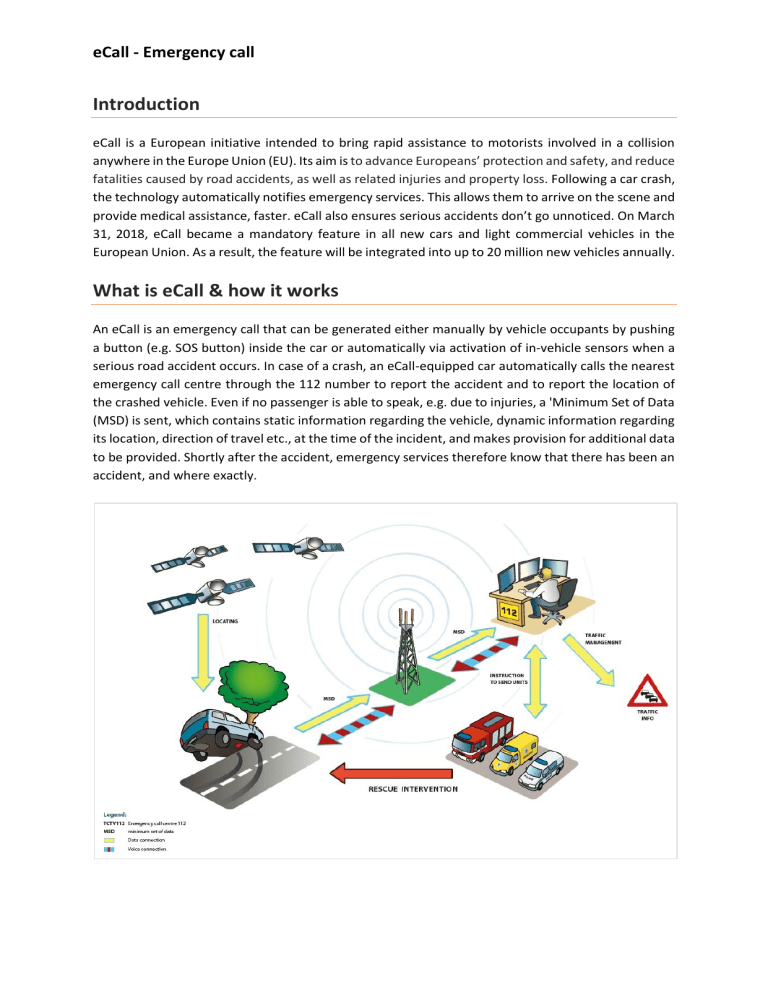
eCall - Emergency call Introduction eCall is a European initiative intended to bring rapid assistance to motorists involved in a collision anywhere in the Europe Union (EU). Its aim is to advance Europeans’ protection and safety, and reduce fatalities caused by road accidents, as well as related injuries and property loss. Following a car crash, the technology automatically notifies emergency services. This allows them to arrive on the scene and provide medical assistance, faster. eCall also ensures serious accidents don’t go unnoticed. On March 31, 2018, eCall became a mandatory feature in all new cars and light commercial vehicles in the European Union. As a result, the feature will be integrated into up to 20 million new vehicles annually. What is eCall & how it works An eCall is an emergency call that can be generated either manually by vehicle occupants by pushing a button (e.g. SOS button) inside the car or automatically via activation of in-vehicle sensors when a serious road accident occurs. In case of a crash, an eCall-equipped car automatically calls the nearest emergency call centre through the 112 number to report the accident and to report the location of the crashed vehicle. Even if no passenger is able to speak, e.g. due to injuries, a 'Minimum Set of Data (MSD) is sent, which contains static information regarding the vehicle, dynamic information regarding its location, direction of travel etc., at the time of the incident, and makes provision for additional data to be provided. Shortly after the accident, emergency services therefore know that there has been an accident, and where exactly. eCall - Emergency call In case of a serious crash in a remote area, valuable time may go by before the crash is reported. Also bystanders or passengers have difficulty in reporting the exact location of the crashed vehicle. The eCall system installed in the vehicle can overcome these problems by sending an automatic message in a European standardized format, containing the location of the vehicle on the basis of an in-built Global Positioning System (GPS) location device. The message will go to the 'Public Safety Answering Point (PSAP)' (fire brigade, police or ambulance call centre), where a decision is made on the appropriate response to the alert. As time is of the essence in this kind of emergency, this process will save valuable time. The Public Safety Answering Points are not yet set and equipped to receive the message in the European standardized format in all European Countries. eCall Models There are three main models that portray the possible functioning of eCall. These models are not exhaustive but merely indicate some major characteristics. The main differences between the models are: • All eCalls and 112 calls are routed (or not) to the same PSAP • Manual and automatic eCalls are routed (or not) to the same PSAP Model 1: eCalls routed as 112 calls: The most appropriate Public Safety Answering Point (PSAP) receives 112 calls and eCalls. Model 2: eCalls routed to a PSAP dedicated only to eCalls: 112 calls continue to be routed to the 112 PSAP. An eCall is identified in the network thanks to the “eCall flag”, which indicates that the call is not a usual emergency call but rather an “eCall”. That way, it can be routed accordingly by mobile network operators. A Member State can choose to outsource the reception of an eCall to a third party instead of a public authority. In this case, eCall is not going to be handled by a public authority, but instead, a private company will manage the state’s eCall service based on 112. Model 3: Manually triggered eCalls and automatically triggered eCalls are routed to different PSAPs: It is possible that it can be the same PSAP as for 112 calls. A PSAP that receives the manually triggered eCall can also be the same PSAP receiving traditional 112 calls. eCall - Emergency call Note 1: eCall flag is a recommendation made by the European Commission. So far, Mobile Network Operators are not obliged to implement it and very few have done so, despite the fact that it is of crucial importance in order to distinguish between 112 calls and 112 eCalls. Note 2: Private companies can offer services similar to the public eCall on their own, called Third-Party-Service eCall (or, TPS eCall), usually as part of a broader set of telematics services. The TPS service that operates privately, is allowed under the three following prerequisites: 1. the TPS eCall in-vehicle system shall comply with the standard EN 16102:2011 'Intelligent transport systems – eCall – Operating requirements for third party support'; 2. manufacturers shall ensure that there is only one system active at a time and that the 112-based eCall in-vehicle system is triggered automatically in the event that the TPS eCall in-vehicle call system does not function; 3. manufacturers shall include in the owner’s manual that the owner may at any time choose to use the 112-based eCall in-vehicle system instead of a TPS in-vehicle system. What are the expected benefits from eCall? eCall has the potential to save many lives by shortening the reaction time of emergency services. This means that ambulances, fire engines and the police can intervene as quickly as possible within the ‘golden hour’, the first hour after the accident when chances of survival are still high. The aim is to reduce the consequences of injury to prevent death and disability. A Swedish study into survivability in fatal road traffic crashes concluded that 48% of those who died sustained non-survivable injuries. Out of the group who sustained survivable injuries, 5% were not located in time to prevent death, 12% could have survived had they been transported more quickly to hospital and a further 32% could have survived if they had been transported quickly to an advanced trauma centre. The European Commission estimated that 112 eCall can speed up emergency response time by 50% in countryside and by 40% in urban areas. By arriving on the scene earlier, any injuries severity can be reduced by 15%. In addition to saving around 2,500 lives annually in the EU, eCall can decrease the financial impact caused by traffic accident by up to €160 billion each year. eCall will be mandatory in the European Union, and operational in Iceland, Norway and Switzerland. The Russian Federation have developed a similar system called ERA GLONASS. The EU and Russia have been working together to make eCall and ERA GLONASS interoperable so that eCall also works in Russia and ERA GLONASS in the EU. Legislation and regulation Legislation On 13 June 2013, the Commission adopted two proposals that complete the Commission strategy on eCall: • Public Safety Answering Points: a proposal for a Decision of the EU Parliament (EP) and Council on the deployment of the interoperable EU-wide eCall in the PSAPs, in accordance with the specifications laid down by Delegated Regulation (EU) No 305/2013: eCall - Emergency call Proposal for a Decision of the EU Parliament (EP) and Council on the deployment of the interoperable EU-wide eCall European Parliament / Legislative Observatory (2013/0166(COD)) In May 2014, the European Parliament and the Council found an agreement on this proposal that provided for: • • • the deployment, at least 6 months before the date of application of the Regulation concerning the mandatory fitting of the eCall device in vehicles (personal cars and commercial light vehicles), of the eCall infrastructure required for the handling of all eCalls on the EU territory, with a final deadline for the deployment set at October 1, 2017. the right of each Member State to organise its emergency services in the way most cost effective and appropriate to its needs, including the right to let private organisations recognised by the Member State deal with the receipt and handling of eCalls, in accordance with the specifications laid down by Delegated Regulation (EU) No 305/2013 . 112 eCalls handling free of charge for the users. The Decision No 585/2014/EU was published in the Official Journal on 3 June 2014. • In-vehicle system: a proposal under the framework provided by Directive 2007/46/EC to mandate eCall in all new types of M1 and N1 vehicles (passenger cars and light duty vehicles). Proposal for a Regulation of the European Parliament and of the Council concerning type-approval requirements for the deployment of the eCall in-vehicle system and amending Directive 2007/46/EC European Parliament / Legislative Observatory (2013/0165(COD)) In April 2015, the European Parliament and the Council found an agreement on this proposal that provided for: • • the mandatory fitting of 112-based eCall in-vehicle system on all new types of M1 and N1 vehicles from 31 March 2018 onward. the right of the vehicle owner to use a TPS eCall in-vehicle system providing a similar service, in addition to the 112-based eCall in-vehicle system The Regulation (EU) 2015/758 was published in the Official Journal on 19 May 2015. Commission Implementing Regulation (EU) 2017/78 and Commission Delegated Regulation (EU) 2017/79 were published in the Official Journal on 17 January 2017. Regulation Of the three technical elements necessary to make 112-based eCall work 1) Vehicle 2) Mobile Network 3) Public Safety Answering Point, items 1 and 3 are mandated. Third party service providers are also part of this regulation. All the necessary measures for legislation have now been completed; the current requirements can be found below. 1. Public Safety Answering Points: • the deployment, of the eCall infrastructure required for the handling of eCalls on the EU territory, with a final deadline for the deployment set at October 1, 2017. eCall - Emergency call • • the right of each Member State to organise its emergency services in the way which is most cost effective and appropriate to its needs. 112 eCall handling free of charge for the users. 2. In-vehicle equipment: • The legislation for the in-vehicle equipment is dealt with by an amendment to the Type Approval Regulations. eCall will form part of the type approval regulation for all new types of M1 and N1 vehicles (passenger cars and light duty vehicles) from 31st of March 2018. With effect from 31 March 2018, national authorities shall only grant EC type-approval in respect of the 112based eCall in-vehicle system to new types of vehicles and to new types of 112-based eCall in-vehicle systems, components and separate technical units designed and constructed for such vehicles which comply with this Regulation and the delegated and implementing acts adopted pursuant to this Regulation. 3. Third Party Service (TPS) provider: • Third Party Services are allowed but not mandatory. They shall comply with the standard EN 16102:2011. eCall Standards ETSI’s Mobile Standards Group Technical Committee, together with the 3GPP (Third Generation Partnership Project) has developed the standards which describe the transmission of eCall data. 3GPP has specified the eCall service telecommunications requirements, data transmission protocols and network signaling aspects. The in-band modem used to transfer the MSD from the vehicle to the PSAP has also been specified by 3GPP. The Minimum Set of Data (MSD) has been defined by CEN Technical Committee 278. ETSI TC MSG has provided overall guidance and has developed standardized test specifications to enable eCall equipment manufacturers to ensure the interoperability of their products. A list of published standards relevant to eCall is summarized below: List of Standards related eCall Description eCall minimum set of data Reference CEN EN 15722 Title Road transport and traffic telematics — eSafety — eCall minimum set of data - Draft EN 081018 Pan European eCall Operating Requirements CEN EN 16072 Intelligent transport systems — eSafety - Pan European eCall - Operating requirements High Level Application Protocols CEN EN 16062 Intelligent Transport Systems - eCall – High Level Application Protocols End to end conformance testing CSN EN 16454 eCall end to end conformance testing Operating requirements for third party support CSN EN 16102 eCall Operating requirements for third party support eCall - Emergency call Third party services supported eCall -Operating requirements CEN EN 16102 Intelligent transport systems — ESafety — Third party services supported eCall -Operating requirements Data registry procedures ISO/EN 24978:2009 Intelligent transport systems - ITS Safety and emergency messages using any available wireless media - Data registry procedures eCall requirements for data transmission 3GPP TS 22.101 ETSI TS 122 101 3rd Generation Partnership Project; Technical Specification Group Services and System Aspects Service aspects; Service principles (Release 9) eCall Discriminator Table 10.5.135d 3GPP TS 24.008 ETSI TS 124 008 3rd Generation Partnership Project; Technical Specification Group Core Network and Terminals; Mobile radio interface Layer 3 specification; Core network protocols; Stage 3 (Release 8) eCall Data Transfer - General Description 3GPP TS 26.267 ETSI TS 126 267 eCall Data Transfer - ANSI-C Reference Code 3GPP TS 26.268 ETSI TS 126 268 eCall Data Transfer - Conformance Testing 3GPP TS 26.269 ETSI TS 126 269 eCall Data Transfer - Characterisation Report 3GPP TS 26.969 ETSI TS 126 969 eCall Data Transfer – Technical Report - Characterisation Report 3GPP TR 26.969 ETSI TR 126 969 3rd Generation Partnership Project; Technical Specification Group Services and System Aspects; eCall Data Transfer; In-band modem solution; General description (Release 8) 3rd Generation Partnership Project; Technical Specification Group Services and System Aspects; eCall Data Transfer; In-band modem solution; ANSI-C reference code (Release 8) 3rd Generation Partnership Project; Technical Specification Group Services and System Aspects; eCall Data Transfer; In-band modem solution; Conformance testing (Release 8) 3rd Generation Partnership Project; Technical Specification Group Services and System Aspects; eCall Data Transfer; In-band modem solution; Characterisation Report (Release 8) 3rd Generation Partnership Project; Technical Specification Group Services and System Aspects; eCall Data Transfer; In-band modem solution; Characterisation Report (Release 8) The communications standards can be obtained through ETSI using the following link Glossary Acronym Expansion eCall EU GPS PSAP MSD EP Emergency Call Europe Union Global Positioning System Public Safety Answering Point Minimum Set of Data EU Parliament eCall - Emergency call TPS CEN 3GPP TS TR ETSI EC Third Party Service European Committee for Standardization 3rd Generation Partnership Project Technical Specification Technical Report European Telecommunications Standards Institute European Commission Reference https://ec.europa.eu/digital-single-market/en/ecall-time-saved-lives-saved https://spectracom.com/products-services/gnss-simulation/ecall-compliancetesting?gclid=EAIaIQobChMIypPhzJih3QIVzRwrCh1FvggyEAAYASAAEgKS-fD_BwE https://ec.europa.eu/transport/road_safety/specialist/knowledge/esave/esafety_measures_unkno wn_safety_effects/ecall_en https://ec.europa.eu/transport/road_safety/specialist/knowledge/postimpact/the_problem_road_t raffic_injury_consequences/survivable_and_non_survivable_road_traffic_injury_en https://ec.europa.eu/transport/themes/its/road/action_plan/ecall_en https://www.euroncap.com/en/vehicle-safety/the-rewards-explained/ecall/ http://www.eena.org/download.asp?item_id=263
